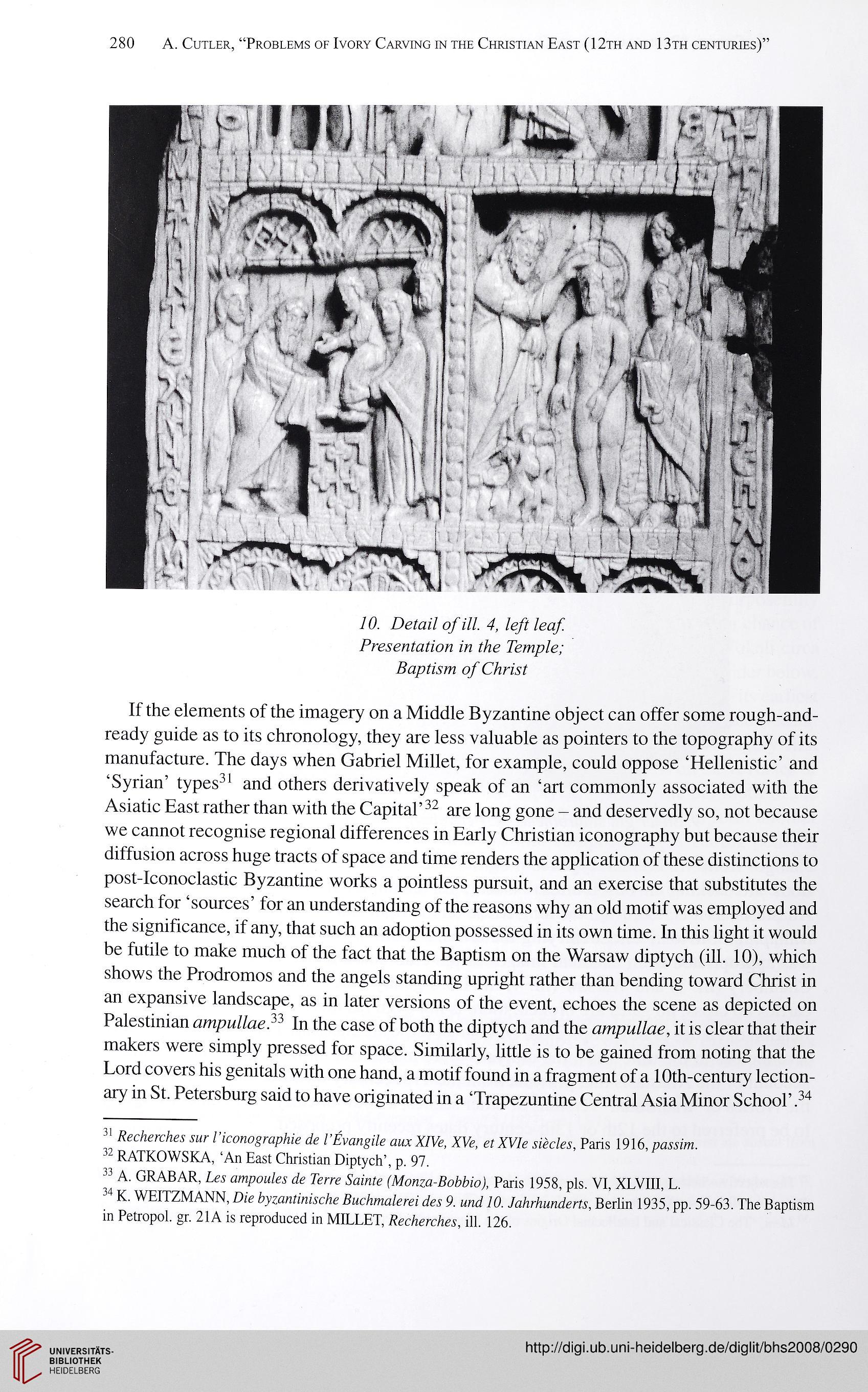280 A. CUTLER, "PROBLEMS OF IVORY CARVING IN THE CHRISTIAN EAST (1ŻTH AND 13TH CENTURIES)"
70. Dg/enV o/TV/. ^7, /g/?
/7t /Ac 77v7?/?/e,'
/A//V/,sw o/ CAnv/
If the elements of the imagery on a Middle Byzantine object can offer some rough-and-
ready guide as to its chronology, they are less valuable as pointers to the topography of its
manufacture. The days when Gabriel Millet, for example, could oppose 'Hellenistic' and
'Syrian' types^' and others derivatively speak of an 'art commonly associated with the
Asiatic East rather than with the Capital'^- are long gone - and deservedly so, not because
we cannot recognise regional differences in Early Christian iconography but because their
diffusion across huge tracts of space and time renders the application of these distinctions to
post-iconoclastic Byzantine works a pointless pursuit, and an exercise that substitutes the
search for 'sources' for an understanding of the reasons why an old motif was employed and
the significance, if any, that such an adoption possessed in its own time. In this light it would
be futile to make much of the fact that the Baptism on the Warsaw diptych (ill. 10), which
shows the Prodromos and the angels standing upright rather than bending toward Christ in
an expansive landscape, as in later versions of the event, echoes the scene as depicted on
Palestinian In the case of both the diptych and the it is clear that their
makers were simply pressed for space. Similarly, little is to be gained from noting that the
Lord covers his genitals with one hand, a motif found in a fragment of a 10th-century lection-
ary in St. Petersburg said to have originated in a 'Trapezuntine Central Asia Minor School'
/?ee7?e/rAe.s yur/'ieonogrnpTn'e <7e /'Avnigi/e mor X/Pe, Xt&, e/XV/e yièc/ey, Paris 19)6, /v;yyim.
RATKOWSKA, 'An East Christian Diptych', p. 97.
^ A. GRABAR, Ley nmponiey & 7erre 5m7i/e (Monza-BoMno), Paris 1958, pis. VI, XLVIII, L.
K. WEITZMANN, Die Ayzmrhm'ycAe DMc/ima/ere;' <7ey 9. 70. JaTir/nm&r/y. Berlin 1935, pp. 59-63. The Baptism
in Petropol. gr. 21A is reproduced in MILLET, Rec/iercAey, ill. 126.
70. Dg/enV o/TV/. ^7, /g/?
/7t /Ac 77v7?/?/e,'
/A//V/,sw o/ CAnv/
If the elements of the imagery on a Middle Byzantine object can offer some rough-and-
ready guide as to its chronology, they are less valuable as pointers to the topography of its
manufacture. The days when Gabriel Millet, for example, could oppose 'Hellenistic' and
'Syrian' types^' and others derivatively speak of an 'art commonly associated with the
Asiatic East rather than with the Capital'^- are long gone - and deservedly so, not because
we cannot recognise regional differences in Early Christian iconography but because their
diffusion across huge tracts of space and time renders the application of these distinctions to
post-iconoclastic Byzantine works a pointless pursuit, and an exercise that substitutes the
search for 'sources' for an understanding of the reasons why an old motif was employed and
the significance, if any, that such an adoption possessed in its own time. In this light it would
be futile to make much of the fact that the Baptism on the Warsaw diptych (ill. 10), which
shows the Prodromos and the angels standing upright rather than bending toward Christ in
an expansive landscape, as in later versions of the event, echoes the scene as depicted on
Palestinian In the case of both the diptych and the it is clear that their
makers were simply pressed for space. Similarly, little is to be gained from noting that the
Lord covers his genitals with one hand, a motif found in a fragment of a 10th-century lection-
ary in St. Petersburg said to have originated in a 'Trapezuntine Central Asia Minor School'
/?ee7?e/rAe.s yur/'ieonogrnpTn'e <7e /'Avnigi/e mor X/Pe, Xt&, e/XV/e yièc/ey, Paris 19)6, /v;yyim.
RATKOWSKA, 'An East Christian Diptych', p. 97.
^ A. GRABAR, Ley nmponiey & 7erre 5m7i/e (Monza-BoMno), Paris 1958, pis. VI, XLVIII, L.
K. WEITZMANN, Die Ayzmrhm'ycAe DMc/ima/ere;' <7ey 9. 70. JaTir/nm&r/y. Berlin 1935, pp. 59-63. The Baptism
in Petropol. gr. 21A is reproduced in MILLET, Rec/iercAey, ill. 126.




